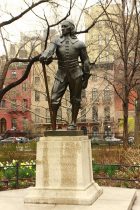One of the most iconic figures from the beginning of New York City’s history, Peter Stuyvesant was a Dutchman whose ambition for power drove him into joining the Dutch West India Company. Upon joining the company in 1632, he looked to tackle expeditions and lead settlements. By July 1646, Stuyvesant was appointed to the general of Dutch territories in North America, arriving in New Amsterdam in 1647. He looked to take immediate action as far as developing leadership boards, as well as a system of laws. Furthermore, he set up a navy and military, better housing and infrastructure(roads), set up essential services like hospitals and sanitation, as well as developed a local police force[i]. Another notably act he accomplished was creating peace between the settlement and local Native American tribes that lived nearby. Stuyvesant spearheaded the project for Wall Street, the protective wall that would later become crucial in the defense of New Amsterdam. Although seemingly doing his best to help and assist his fellow settlers, he was very much distrusted and unliked. He was extremely opposed to all other religions that weren’t his own such as the Jews and Lutherans. Settlers were worried about his dominating personality as well as his tendencies to aim to please only the Dutch West India Company rather than the people of New Amsterdam. Unfortunately, in August of 1664, Peter Stuyvesant was forced to surrender by his people to the oncoming British Navy and troops. His dedication, as well as his added development to the city, made it highly desired and the long Dutch territory was forfeited to British hands.

This is a statue of the Peter Stuyvesant resides in Stuyvesant park as a tribute to his dedication and leadership in the Dutch New Amsterdam city. Commons: Wikipedia Takes Manhattan project on April 4, 2008.
[i] Burns, Ric, James Sanders, and Lisa Ades. New York: An Illustrated History. New York: Alfred A. Knopf, 2005.